The Moto Guzzi Eagle takes flight through the “gateway to Africa”. A 10-day journey that’ll make you fall in love with Tunisia, as you listen to the pulsating rhythms of our twin-cylinder engines from Mandello del Lario, together with a glistening international convoy of The Clan community members, discovering unforgettable landscapes, archaeological masterpieces, and excitement in true Guzzi style: this is the Moto Guzzi Experience Tunisia 2019!
Read our story, stage by stage, and take a look at some of the best photos in the photo gallery.
STAGE 1 – FROM ITALY TO TUNIS: AWAITING THE AFRICAN SUN
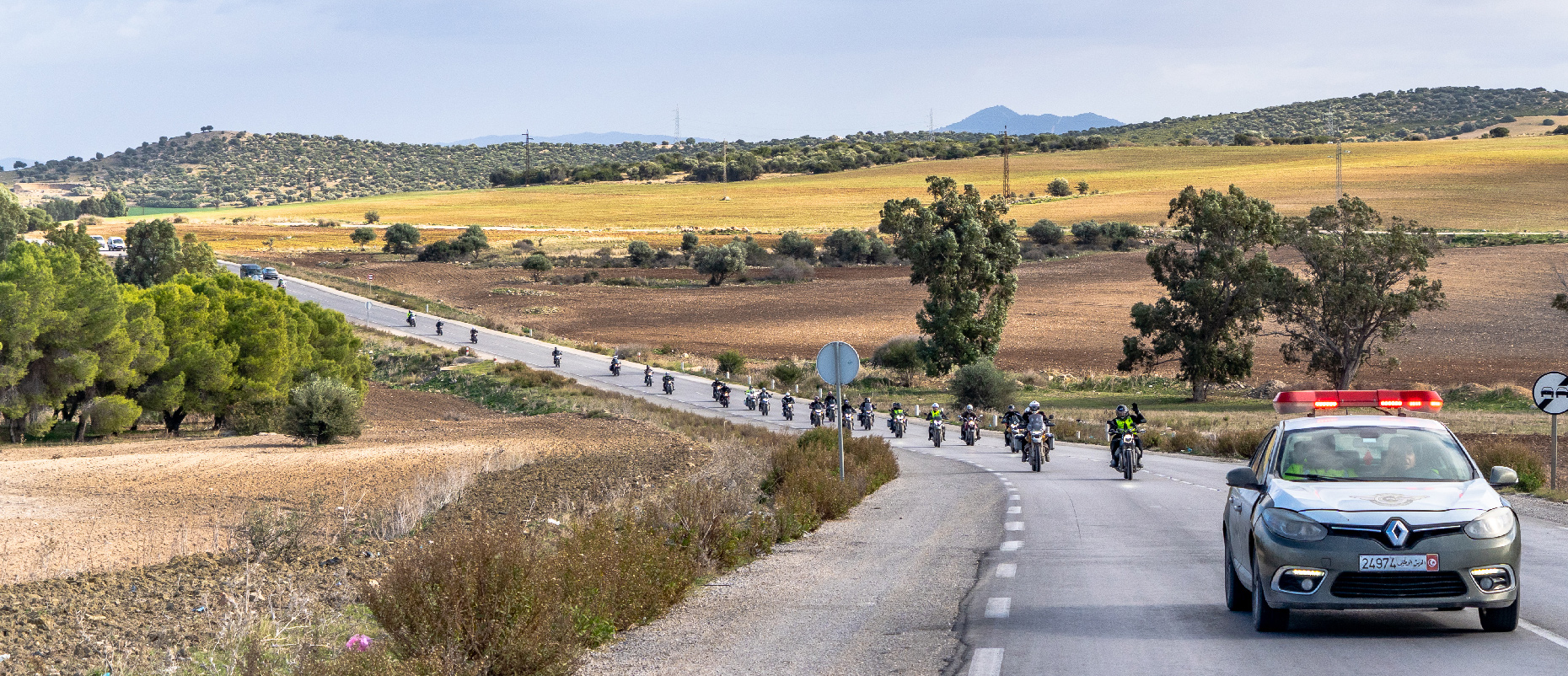 Setting off on a journey is never quite how you imagine it to be, but rest assured that that lump in your throat caused by a mix of trepidation and excitement will always be there; especially because winter in Genoa is more than harsh; it’s gale-force winds out there!
Setting off on a journey is never quite how you imagine it to be, but rest assured that that lump in your throat caused by a mix of trepidation and excitement will always be there; especially because winter in Genoa is more than harsh; it’s gale-force winds out there!
Strong winds and pounding rain plough down on our 26 Moto Guzzi motorcycles, which are ready and waiting to embark upon the Moto Guzzi Experience Tunisia. Was it an adventure we wanted? Well here it is!
People say their farewells and then get in line to collect their TomTom Rider 550s, with each day’s route downloaded onto them, and the keys to our brand-new Moto Guzzi motorcycles. Some of us don’t need them, as we came on our own Moto Guzzi bikes, but now’s not the time for introductions: we’re off! We’ve got a ferry to catch and a 24-hour sea journey, but… hold on a moment: a traveller, just a bit too carelessly, rocks up on his super-equipped V85 TT, but without a passport. He manages to get it delivered to him from Milan just in time to “jump” on board the boat: tonight, drinks are on him!
We’re on board and finally have some time to take a good look at each other during the first of many briefings to come.
The staff begin their presentations. Three guides: two travelling by motorcycle and one that will be at the back of the group with the first four-wheeled support vehicle. Behind, there will be just one van carrying two Moto Guzzi technicians, together with spare parts and reserve motorcycles (better to be prepared!).
Attentive ears listen to the instructions about the strict plan that awaits us, and smiling lips savour the spirit of the journey, as well as that of the group. Speaking of the group, it is an international crowd from the United States, France, Germany, Finland, Switzerland and – of course – Italy. All united by their membership to The Clan and their passion for the Eagle from Mandello del Lario. Tunisia awaits us!
Rough seas wake us up early: it seems that the weather in Tunis is no better than what we’ve left behind. We’ve run into our fair share of setbacks, customs stamps and complications, but we don’t care: we made it! It’s late afternoon and the tyres of our Moto Guzzi bikes are on African soil! To be fair, it’s wet tarmac rather than soil, it’s dark, the streets are dimly lit, and it’s only a few kilometres to the hotel, but we’re already excited when we see our rumbling convoy ready to take on Tunisia… is it a bit too much? Not at all!
STAGE 2 – FROM TUNIS TO TABARKA (ABOUT 270 KM): FINALLY ON THE ROAD! (HOW NOT TO GO BY UNNOTICED)
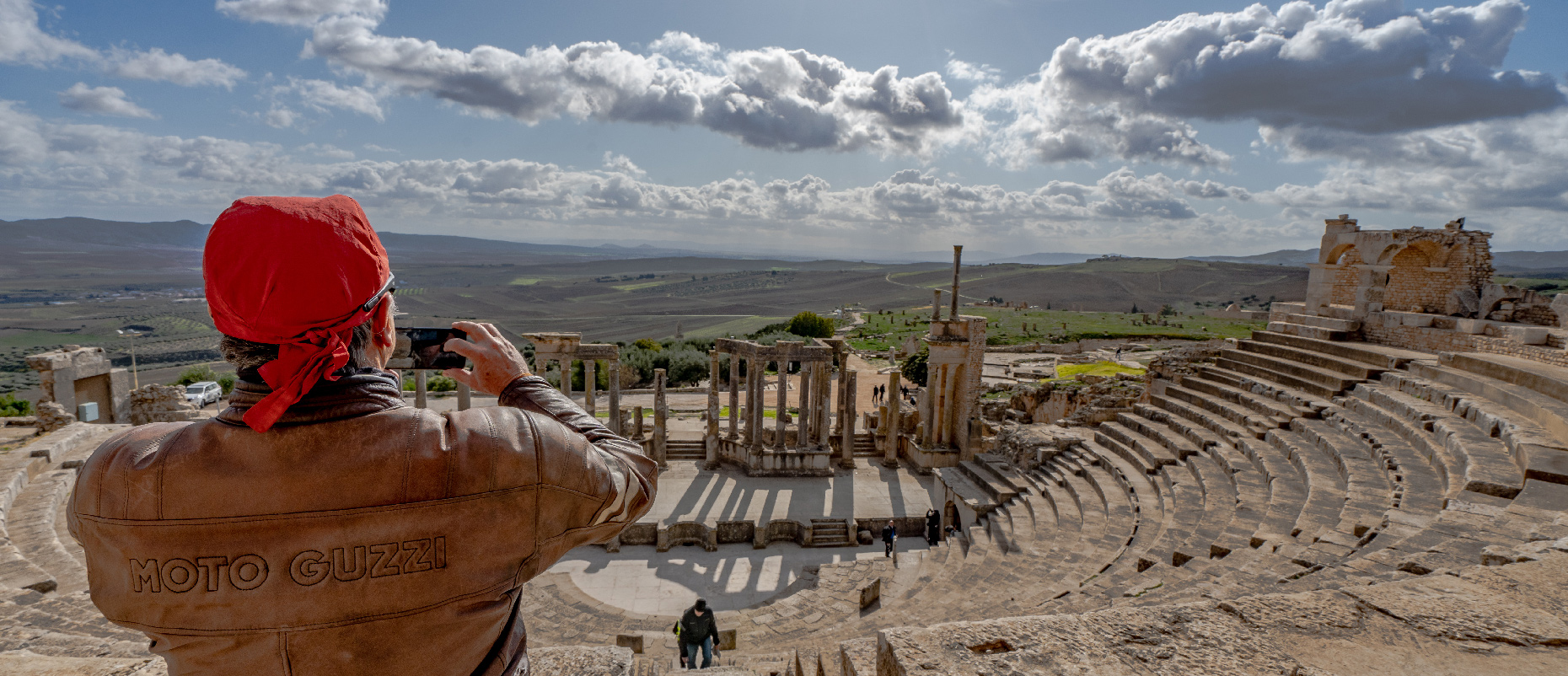 It’s only 8 in the morning of our first day on the road, and there are three things that we already know will be with us right up until the last day:
It’s only 8 in the morning of our first day on the road, and there are three things that we already know will be with us right up until the last day:
1) the hotels in Tunisia are huge, uncomfortably lavish, and semi-deserted; evidence that tourism is slowly picking back up after a decade of crisis;
2) this will be our daily departure time: “8.00 a.m.: butts on the saddles!”, our guide chimes in; and woe betide anyone who’s late!
3) the Tunisian government cares a lot about its tourists, especially if they’re motorcyclists: the Tourist Police are waiting for us at the entrance of the hotel (not that they were invited). They’ll be escorting us – or, even better, freeing up the road with sirens ablaze – for the first few days of the journey, with a string of changes from one car to the next, like a well-orchestrated ballet performance, at the border of every governorate.
We soon realise that the Tunisian police forces are better travel buddies than we could ever have imagined, considering their flexibility with speed limits, as we’re constantly trying to keep on track with our tight schedule, and their help getting us through the traffic on the outskirts of Tunis; they even seem to almost “tackle” cars and lorries to get them to allow us through. Essentially, thanks to the lights, sirens, and the rumbling of our twin-cylinder engines, there’s an immediate “presidential procession” effect. Heads turn, women wave, and smartphones film us (which we’ll see less and less of after leaving Tunis): “Who are they? Perhaps they’re Berber princes with their convoy of camels?”. At first it all seems kinda weird to us; this “circus” certainly does not help us to go unnoticed and blend into the scenery, but we’ll then discover, through the excitement in the eyes of our “spectators”, especially the children, that this striking bit of a commotion is about to reward us with some of the strongest emotions we’ll go through during the Moto Guzzi Experience Tunisia.
What we are less thrilled about, however, are the rain and the cold, which accompany us for the majority of the morning’s ride. Fortunately, winter’s grip loosens just as we are approaching the first stage, with the sun finally lighting up the road towards the ruins of Dougga.
Visiting this UNESCO world heritage archaeological site, one of the most important ones in the country, helps us to become familiar with the magnificence and perfectly preserved remnants of the various cultures that have left a mark on the history of Tunisia. In front of us, there’s a whole hillside to explore, as we walk along cobbled streets and beneath Roman arches, wander into Numidian and Punic temples and mausoleums, and discover a spectacular Roman theatre nestling on the hillside.
The expanse of the ruins of Dougga hits us even harder when we realise that we’re alone. But we’ll get used to it, especially in this north-western region of Tunisia, which is full of attractions but historically hardly ever touched by the tourist routes heading south. A godsend for group photos. Click: that’ll be the first of many! But not everyone is enthused by them, and so begins the running joke/nightmare/gag of the Experience, announced with a strong German accent: “photo di groupo!”, prompting everyone to pretend to run away.
Lunch consists of delicious lamb chops served with some lethal chilli sauces (which, by the end of the journey, we actually end up managing to eat on our bread) and then it’s already time to leave. Before us, there is a long and guided mountain trail going through lush landscapes, but rain, wind, and cold make it challenging and seemingly never-ending. So we get to Tabarka by following flashing lights in the dark; tired, shivering, and with much to process after this first intense day on the bikes. We’re on a journey; how cool! But is this the real Tunisia? When will we get to see the dunes and the camels? When will we get to see the desert?
STAGE 3 – FROM TABARKA TO SBEITLA (ABOUT 300 KM): CHASING SUNSETS
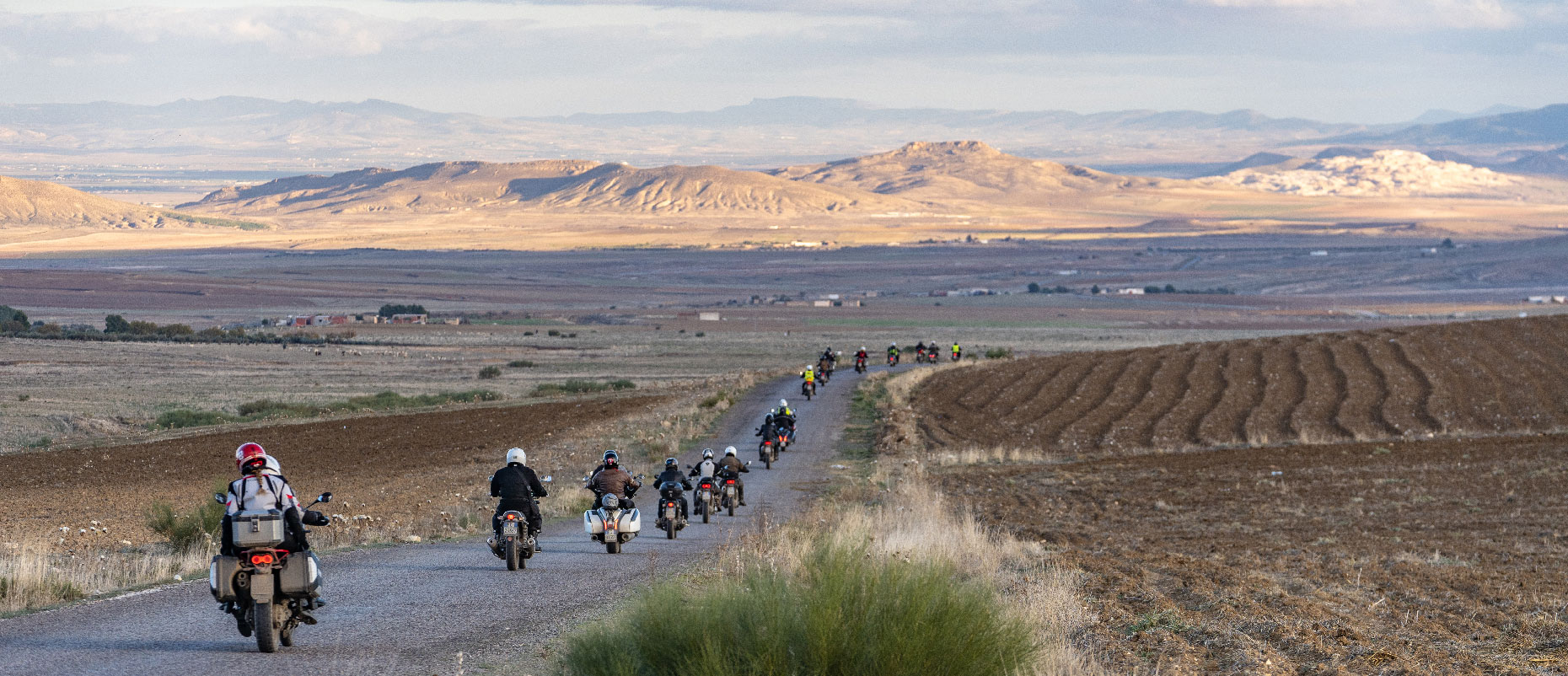 The weather hasn’t improved, so much so that upon leaving Tabarka, we don’t even realise that we’re near the sea, even if it is only for a few kilometres. However, waiting for us is a wonderful mountain road, with smooth curves and views of… the fog, which luckily breaks up at just the right time, as we cross the pass, with our bikes in single file and our visors still misted up. It is a display of verdant shades, saturated with rain drops; but further ahead, towards the south, there’s the sun, and that’s where we’re heading. Today and tomorrow, in fact, our wheels will be running alongside the border with Algeria: it is a highly militarised area, and seeing the armed soldiers reminds us how extremely limited access to tourism is beyond the border, and how going through this region on our Moto Guzzi bikes is a small privilege.
The weather hasn’t improved, so much so that upon leaving Tabarka, we don’t even realise that we’re near the sea, even if it is only for a few kilometres. However, waiting for us is a wonderful mountain road, with smooth curves and views of… the fog, which luckily breaks up at just the right time, as we cross the pass, with our bikes in single file and our visors still misted up. It is a display of verdant shades, saturated with rain drops; but further ahead, towards the south, there’s the sun, and that’s where we’re heading. Today and tomorrow, in fact, our wheels will be running alongside the border with Algeria: it is a highly militarised area, and seeing the armed soldiers reminds us how extremely limited access to tourism is beyond the border, and how going through this region on our Moto Guzzi bikes is a small privilege.
We start to get a rhythm going and quickly realise that we should be making the most of every time we stop for petrol, about every 150 km (the larger 1400s are the most parched): to stretch our legs and to make friends with some Tunisians! Despite being almost always alone at tourist sites, it seems that a large part of local life centres around petrol pumps and rather run-down two and four-wheeled vehicles (the immortal and ever-overloaded Peugeot 404 and 504 pickup trucks, some of which have been around since the ‘60s, are everywhere and soon become a cute little fixation for some of us). The time needed to fill up all of the bikes is enough to fit in at least 20 photos with members of every family and, without fail, to meet someone who speaks Italian or English and wants us to tell them everything about our expedition. Turn after turn, the engines of our Moto Guzzi motorcycles show us that they are the key to meeting people, who, as we will learn, are always willing to gift us with some time out of their daily lives. It makes us feel a little less like tourists, a little more like travellers, and definitely more like motards, as they call motorcyclists here.
By the time we get to Le Kef, the clouds have lifted, leaving us a glimpse of beautiful blue sky, which makes the view we enjoy from the top of the Kasbah look even more stunning: a famous Ottoman fortress built to protect the border with Algeria. A white road leads us towards lunch at a beautiful holiday farm, whose young owners refuse to let us go without a group photo of everyone all together.
As of this point in the journey and for the rest of it, we can kiss the rain goodbye, as the weather goes back to being more like what we were expecting from a Tunisian winter: almost 10°C of diurnal temperature variation, with 10/13°C in the morning and in the evening, and 20 wonderful degrees of sunshine in the middle!
Once we have taken off a few layers of clothing, we are more willing to tackle the long, straight, and well-paved roads that stretch out almost as far as the eye can see towards the plains up ahead. Upon the horizon, all we can see is the flat profile of an unusually shaped mountain: it resembles a chopped-down tree trunk, as its surface looks so even. It is Jugurtha’s Table: a natural fortress covering 80 hectares with a height of more than 1,200 metres, formed by differential erosion and used as a refuge by the Berbers for centuries. The top can be accessed via a stairway that has been carved into the rock, after passing a narrow and steep little road with the bikes. The view is breath-taking: the light is fading, but further down below we can see it seeping through onto the arid hillsides of the Kabylia, the area that separates the Mediterranean side of Algeria from the desert side.
Let’s be honest: our plan was to always get to the hotel before it gets dark, but who could resist admiring such a beautiful sunset? We allow ourselves a few minutes to enjoy the view despite our tyrannous schedule, before taking on the last few kilometres that separate us from Sbeitla.
STAGE 4 – FROM SBEITLA TO TOZEUR (ABOUT 290 KM): FROM ANCIENT ROME TO MOUNTAIN OASES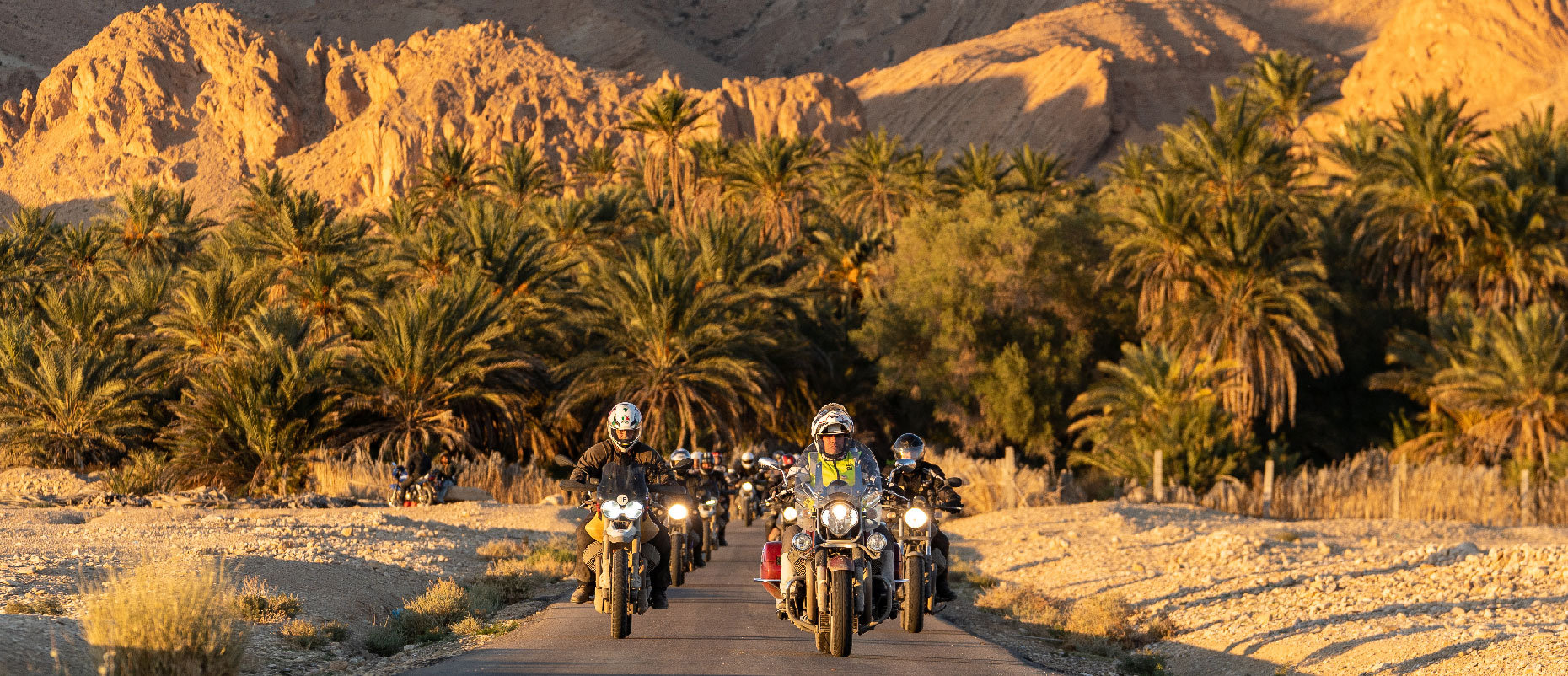 Waking up in Sbeitla is different. We are in the heart of Tunisia and the pristine and crisp air is telling us that we are entering the core of the journey: today is going to be a special day!
Waking up in Sbeitla is different. We are in the heart of Tunisia and the pristine and crisp air is telling us that we are entering the core of the journey: today is going to be a special day!
A few hundred metres from the hotel and we find ourselves strolling amongst some of the country’s best-preserved Roman ruins. The archaeological site of the ancient Roman city of Sufetula (“Sbeitla” comes from this name), although smaller than the one in Dougga, still surprises us with its many mosaics and the majesty of its very own Capitoline Hill. Three temples alongside one another, dedicated to Jupiter, Juno, and Minerva, which – unaware of the centuries that have passed – cast long shadows onto our shaky figures, which are slightly sleepy yet also thrilled. Once again, it’s just us here, together with a local gentleman wearing a Burnous, a traditional Maghrebi cloak generally made out of camel wool, who keeps watching us with a curious gaze. What is the real attraction of Sbeitla these days?
Off we go, back on our bikes! The first 170 km of the day await us, just enough to wake us up and lead us towards a succession of ever-changing landscapes that become increasingly desert-like: first they’re hilly, then flat, and then mountainous.
It’s mid-morning when we come across a number of strange handovers between Police cars, which since Tunis have never left us: everything is fine until the new escort goes off at warp speed, finally leaving us to our own devices (we’ll see them again only occasionally during the last few days of our journey): Tunisia is all ours now!
We are enjoying a lunch of delicious grilled meat skewers, on a terrace in Moularès, when we find out that one of our French pals doesn’t feel like riding anymore: he’s lost some important medication. Whilst a victorious “operation pharmacy” is underway, what up until now was an Italian passenger offers to drive the currently driverless LED-lit V7 III Stone Night Pack; we then discover that she’s also a great motorcyclist (two days later, however, our original motard feels better and is ready to get back on his bike!).
Many of us think of oases as being amidst the dunes of the desert, but the three that we’re about to see are mountain oases. Three of nature’s masterpieces one after the other, thanks to one of the most beautiful and winding roads that we’ll go on throughout the whole journey. Passing by one oasis to the next: what more could we want?
First came the Midès Canyon. Just one kilometre away from Algeria, hanging over a dizzying crack, we can admire the multi-faceted colours of the rocks, which have been eroded and smoothed down over the millennia by streams to form a perfect natural defence for this ancient village. To reach the bottom, we go past the ghostly remains of the village’s mud-brick houses, which were destroyed by the floods of 1969 that took several lives. A tragic scene that tells us how little knowledge these people have about water.
Then Tamerza: the largest mountain oasis in Tunisia. We are blown away by the colours on display across various market stalls, and by a small canyon with its enchanting 5-metre waterfall. It is the perfect moment and place to have a mint tea: just like the caravaners used to do in the past, we too are enjoying a refreshment today, drawing from the stubborn water source that gives life to this unique place. It is also the right time to “get our bikes’ wheels dirty” along the short access dirt road: a few people can’t resist having a go at riding rally-style, standing up on the foot pegs of their V85 TTs or rallying around in the small ford.
Lastly, Chebika. A small, 1-kilometre detour and our convoy is hurtling down a pathway that goes through a lush palm grove. We come out on the other side and find ourselves immersed in an oil painting: behind us there is just palm trees and mountains, lit up by the warm light of the sunset, whereas in front of us there is an expanse of purple from the small salt lake of Chott el Gharsa, and then lastly, on our left, we even catch our first glimpse of some dromedary camels!
We are overwhelmed by all of this: the shades, lights, and evocative images that give Tunisia its nickname of “the gateway to Africa”. The last few kilometres of the day are spent as follows: intoxicated, almost in a daze, and instantly relieved from any fatigue, looking around at one another as we light-heartedly race towards Tozeur on our Moto Guzzi bikes; on the way to the Sahara!
STAGE 5 – FROM TOZEUR TO DOUZ (ABOUT 210 KM): KNOCKIN’ ON SAHARA’S DOOR
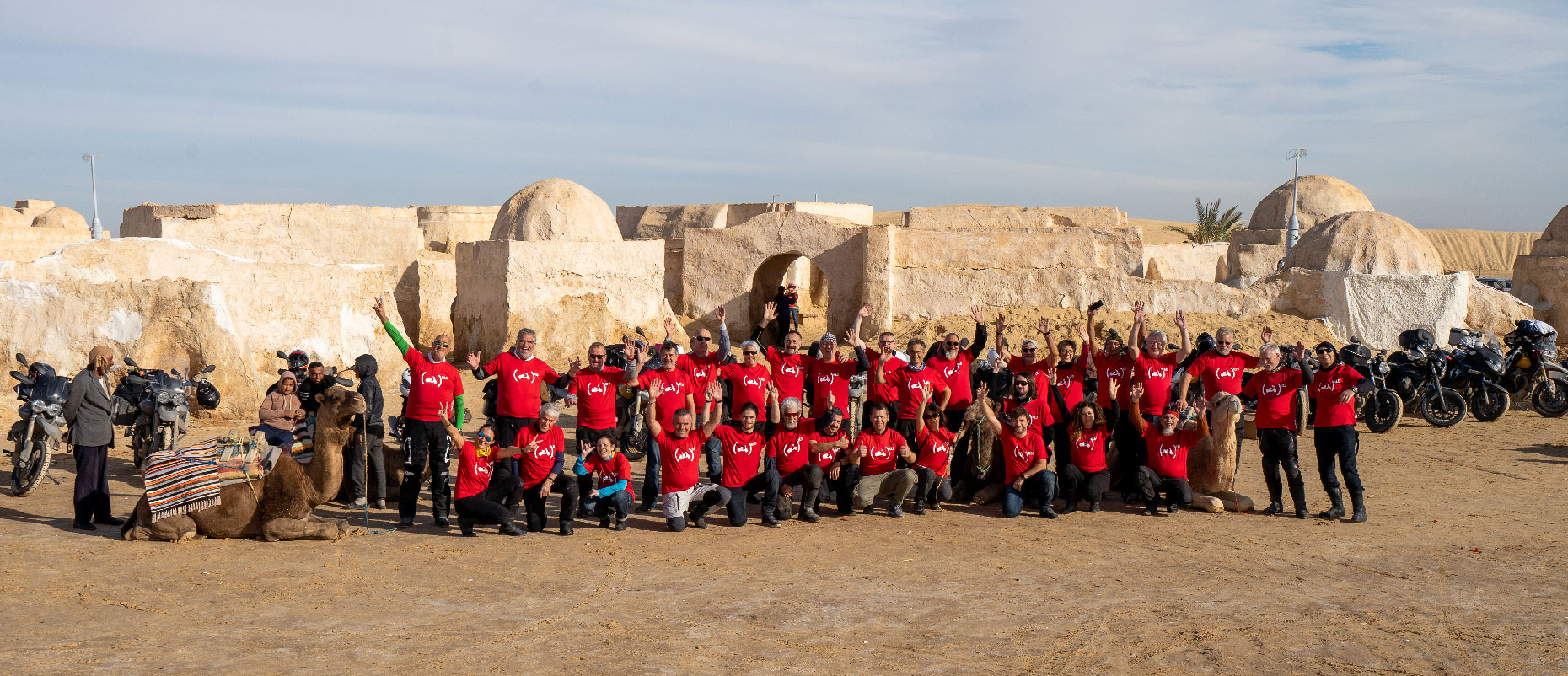 As if the atmosphere of our expedition were not surreal enough, the first half of today really makes our imagination fly: a detour to the west from our southern route, passing through the village of Nefta, takes us to Ong Jmal, one of the most famous and best preserved cinematographic locations of the Star Wars saga.
As if the atmosphere of our expedition were not surreal enough, the first half of today really makes our imagination fly: a detour to the west from our southern route, passing through the village of Nefta, takes us to Ong Jmal, one of the most famous and best preserved cinematographic locations of the Star Wars saga.
The narrow strip of asphalt, which is 25 km long, cuts through the desert, following the sinuous curves of what – only six months ago – was a track in the dunes. Along with the good fortune of being able to reach the village built by George Lucas in the late ’70s on a motorbike, there’s the pleasure of facing alone, in the almost blinding light of the morning, this road with “grippy” asphalt, all to be ridden.
Ong Jmal owes its name to a strange formation of sandstone that resembles a camel’s neck (literally: Ong Jmal), and it is said that it was right here that the American filmmaker found the inspiration to create the Star Wars universe. What remains today is a good part of the structures of the set of “Mos Espa” (as it was called in the films) and a group of locals ready to welcome visitors with their dromedaries: “Un dinar, un dinar pour la photo, s’il vous plaît!”. This “touristic” approach, in the most ordinary sense of the word, almost reassures us: at least here some of the business seems to survive. So, while we visit the set, we let ourselves enjoy a few camel rides, ending in a group photo of bikes, riders, and camels lined up, and finding ourselves shouting comically unclear instructions in a jumble of languages: “That camel needs to be moved at least two metres further over! Yes, like that, sitting, not standing!”. But it’s not just a chance to have a good laugh, as we also take the opportunity to wear the (VESPA 946)RED T-shirts, in support of the Global Fund to Fight AIDS, which provides essential HIV/AIDS drugs to villages in sub-Saharan Africa. We’re sure that, just for today, the Moto Guzzi Eagle will forgive us.
It’s almost time to get back on the road, but it’s impossible to resist the completely empty clearing at the foot of the imposing sand dune adjacent to Ong Jmal. A nod of approval from the guides and we unleash ourselves into a whirling motorbike carousel on the sandy square, where some of the more clever among us hint at some drift, while others simply enjoy the show, savouring these moments of pure freedom on the seat of our Guzzi bikes. We feel like kids again, but one of our expedition’s “dads” decides to give us a demonstration of how grownups do it. One of our guides climbs onto a V85 TT – selects Off-Road riding mode – and charges towards the climb to the dune with the engine revved up. He goes up and down several times, caressing the ultra-fine sand (it looks almost like talc) with the front tyre, raising fountains of dust with the rear one, without a hint of smearing and with the confidence of those who are not at their first rodeo.
Having seen the potential of the Tuttoterreno with our own eyes, one of us finds the courage to try his hand at challenging the dune, to baptise his own V85 TT with the sand of the Sahara, which is not just any desert, but one that gave its name to the iconic yellow, white and black livery of his bike. As they say, opportunity never knocks twice. The daredevil climbs with no problem, followed by a resounding ovation, but on the way down things gets complicated, and after just a few metres the soft dune swallows his front wheel, sending him legs in the air in slow motion, amidst uproarious laughter.
Once the sand has been cleaned off the V85 TT, we return to Tozeur for an outdoor lunch in typical Arab style, immersed in the city oasis under the shade of one of the largest palm groves in the world. Here, every meal ends with dates: Tozeur is considered the world capital of dates and we are tasting the Deglet Nour variety, considered the absolute best among the more than 180 known varieties. As the saying goes, “The more you get, the more you want”, and leaving the city we end up bargaining for the purchase of a 10 kg box that we’ll share at the end of the trip.
We are separated from Douz by the crossing of the vast salt lake Chott el-Jerid, which Herodotus described as “Lake Triton”. Although there is no concrete evidence, it is believed to be connected with the Mediterranean Sea (over 150 km away) because it seems to be affected by the flow of tides.
We ride on the very long straightaway (over 50 km) that runs straight on an embankment, while all around us the off-white colour of the salt glistens in the sun, bringing sky and earth together in a quivering mirage.
We complete the crossing and arrive at Douz, the starting point for most of the off-road tours in the Tunisian Sahara. We are reminded of this by the view of the dune that, unperturbed, reaches the town, untamed by the asphalt, sidewalks, and streetlights. From here to the south, sand reigns – almost – supreme, but our mission points in a different direction.
At the hotel, some of us take advantage of the hammam. We deserved it, and tomorrow’s going to be a long day!
STAGE 6 – FROM DOUZ TO TATAOUINE (ABOUT 310 KM): HIDDEN TUNISIA
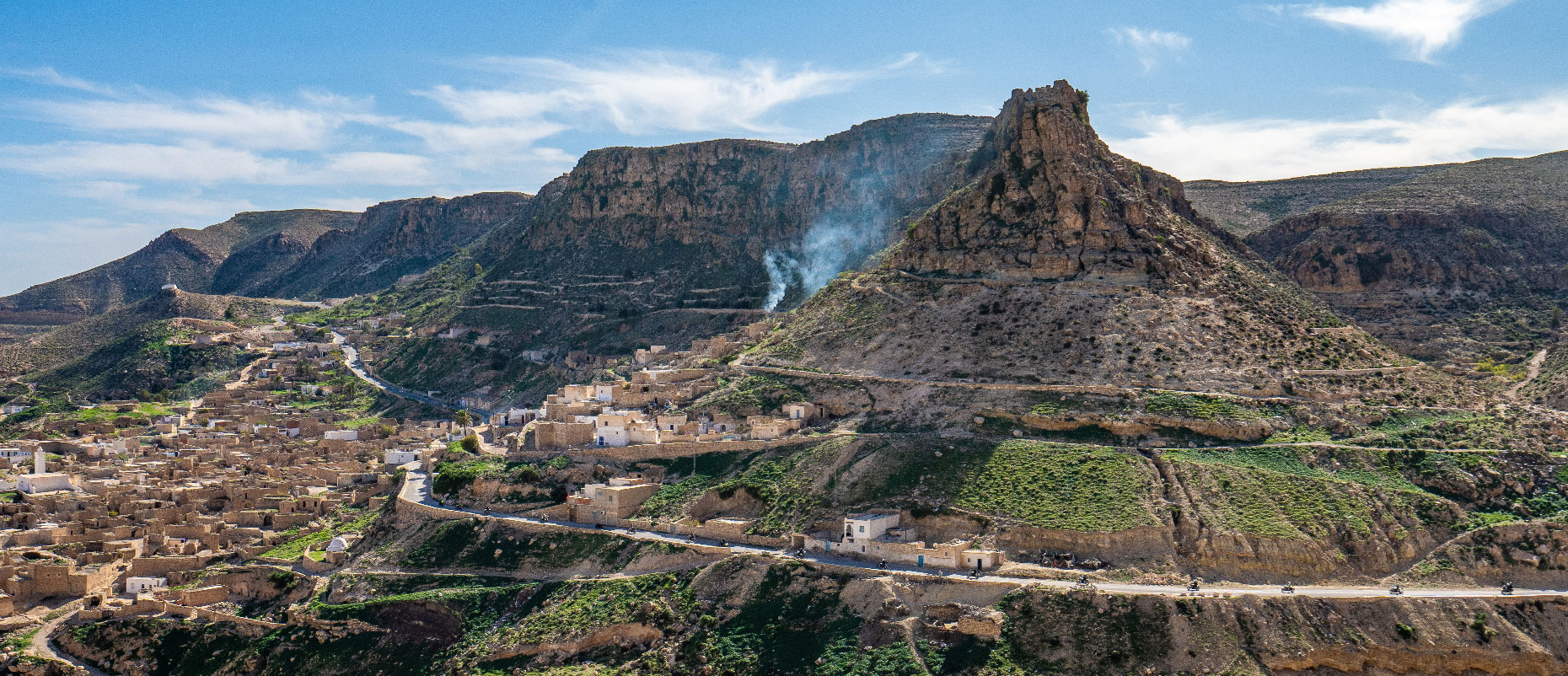 8:00 a.m., on the saddle and ready to go but… all halt: there’s a surprise. Not the police, but a crew from a local radio station that has come to film us! Apparently, we sparked more attention than we imagined.
8:00 a.m., on the saddle and ready to go but… all halt: there’s a surprise. Not the police, but a crew from a local radio station that has come to film us! Apparently, we sparked more attention than we imagined.
A few short interviews in French and we hop back on the saddle for one of the most intense days of our Experience, which today will take us to touch and cross various desert landscapes.
It doesn’t take long to leave the silhouettes of the dunes behind us, making our way into a mountain desert, where the straight stretches give way to magnificent curves. After an hour of riding, we stop at Tamazret, right at the top of a particularly exciting stretch of riding. So, while some of us sip a very special almond tea and taste the “gazelle horns” (local sweets made of puff pastry filled with almonds and honey, reminiscent of the shape of a horn), we take advantage of the pause to take some photos of six die-hard bikers leaning in, who seem to never have enough of curves and kilometres.
We rejoin the group at the entrance to Matmata, a picturesque Berber village, with its typical building style of troglodyte houses carved into the rock that we’ve already begun to glimpse over the last few kilometres. When we arrive in the village, however, we discover that the forced fuel supply can’t be carried out at the petrol station, which had closed who knows when. The only thing to do is ask for help from the inhabitants, who bend over backwards to find 5 litres per bike, which is enough for us to continue. In just a few minutes we become the town’s entertainment for the day, and the mishap, as always happens, proves to be an opportunity to break through the rhythms and boundaries imposed by our fully-packed schedule, letting our helmets take in a bit of that human landscape that we have seen for days now whizzing by us. But everything has a price: our schedule is unforgiving and the visit to Matmata has to be skipped. We get back on the road with no regrets, because what’s ahead is even better!
In fact, from here begins an important detour. We don’t want to get to Tataouine on the classic route, but by making an impressive deviation of almost 100 km in the Dahar region, best known for the ksour, which are spectacular fortified Berber granaries/villages, whose undulating cellular architecture is somewhat reminiscent of Catalan modernism and the works of Gaudì. The area is so rich in historic vestiges because it is here, protected by the mountains, that these indigenous populations of “free men” (this is the meaning of the word “Berbers”) took refuge after the Arab invasion of the plains.
While motorbike caravans are a rare sight in all of Tunisia today, this area looks completely unspoiled by the passing of bikes. With non-existent traffic and not a single tourist in sight, we enjoy even more the view of the wide valleys, while the narrow passages in the villages, which we cross at walking pace, gift us the sight of children, their eyes filled with wonder. They run around us, extend their hands to give us a high-five, sealing a silent and smiling agreement: neither we nor they have ever experienced a moment like this.
We are in Tataouine for lunch, but when it’s time to get back on the bikes we realise that one of the V85 TTs has a flat tyre (it will be the only inconvenience in 10 days). All we have to do is raise a hand for our unflappable Moto Guzzi mechanics to go into action. There’s no time to change the inner tube, so the bike is replaced on the fly with another one kept in the van and, just a few minutes later, we head out (the repair will be completed that same evening at the hotel, and the next day, “Deflated”, as the bike is renamed, will be ready to set off again).
The day ends with a visit to Ksar Ouled Soltane, the most spectacular of all the ksour, with its four-story cellars (usually only two can be found), and then to Chenini. As dusk sets in, we park our bikes in the square at the foot of the most famous troglodite Berber village, nestled in a protected position on the side of a mountain. There is only time for a short walk accompanied by our guides, who tell us that 10 years ago, even at this hour, the square would have been so packed with tourists that it would have been hard to find a place to park a single bike. Today, 10 years after the start of the crisis in this industry, which began with the Arab Spring and continued with the Jihadist terrorist attacks of 2015 in Tunis and Susa, we are the only visitors present.
By the time we leave the sun has set, though the temperature has still not dropped. We cover the few miles separating us from Tataouine, hypnotised by the last flares of the vermilion sunset, projected onto the mountains as if they were part of an enchanting shadow play, with a long trail of red tail lights wagging joyfully in front of us.
STAGE 7 – FROM TATAOUINE TO EL JEM (ABOUT 350 KM): ALL ROADS LEAD TO EL JEM
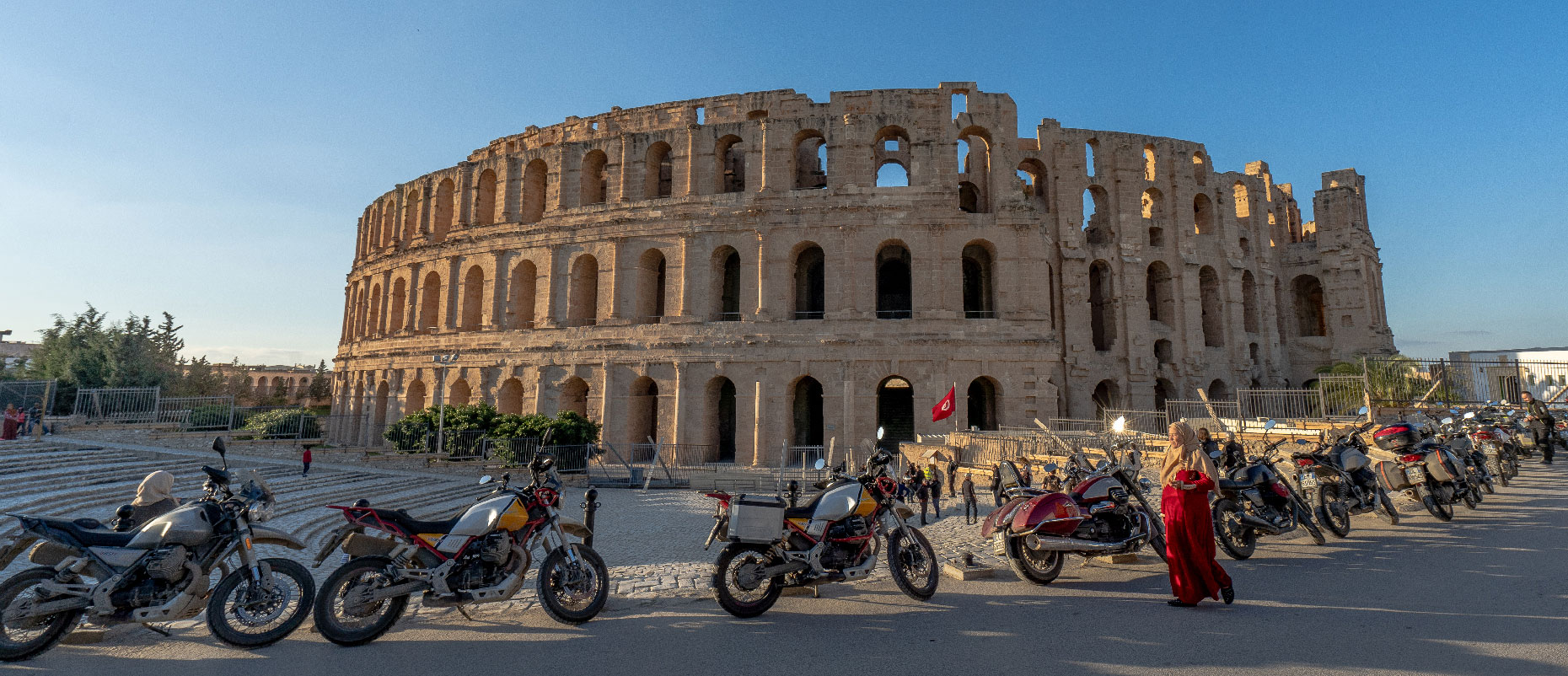 We left 8 days ago, and have explored Tunisia as far as the inhabited southern districts. Beyond lies the immense Desert Horn, bounded to the south-east by Libya and to the south-west by Algeria, but the time has come to quickly make ground as we travel northwards. Today we will be covering many miles of rather boring roads, but Tunisia still has quite a few tales in store for us!
We left 8 days ago, and have explored Tunisia as far as the inhabited southern districts. Beyond lies the immense Desert Horn, bounded to the south-east by Libya and to the south-west by Algeria, but the time has come to quickly make ground as we travel northwards. Today we will be covering many miles of rather boring roads, but Tunisia still has quite a few tales in store for us!
After days of wide open spaces and quiet roads, we regretfully make our way back to city streets, which certainly pose the biggest challenge to the passing of our long caravan of bikes and vans. Many participants volunteer to help the staff keep the group together, stopping the traffic at crossroads and roundabouts, but there is a problem that even the best thought-out planning could not solve: a lack of parking!
Our first stop is supposed to be at the ksar in Medenine, but today is Saturday: market day. Picturesque, rowdy and crawling with life; we would love to immerse ourselves in the colours and aromas of the market stalls, but it is absolutely impossible to find a place for our group to park. Farewell ksar, see you next time! All we can do is stop on the outskirts of the town for morning coffee. The tour leader pulls over, and everyone follows in an orderly manner; helmets off, and then we look up at the sign hanging over the café… “Caffè Bolzano”. They may be Tunisian, but they sure know how to make Italian espresso!
“Back on your bikes!”, the guide orders, and so we all diligently head off for the highway running along the Mediterranean coast, even though we will see the sea only once we reach Mahres. The sun is shining, the temperature is mild, and we are able to enjoy a delicious fish lunch with a view over the bay dotted with flamingoes.
We still have to cover the last 100 km to El Jem and its picturesque amphitheatre, declared a UNESCO World Heritage site. The hotel is just down the road, but we park our bikes around the impressive Colosseum, the world’s 3rd largest, just in time to enjoy a sunset-lit view lit which leaves the Italians astounded: how did we manage to end up in Rome?
Checking in at the hotel, for the first time we find a crack in the ritual we have by now learned to follow: that of the Germans (though to be honest there’s also a Swiss in the bunch) and their “welcome” beer. Nobody can beat them to the first well-deserved bottle of Celtia (an excellent Tunisian beer), their helmets still on and their passports in their hands; after all, from morning until we reach our destination, alcohol is a no-go. But in this grand hotel in El Jem, they only have alcohol-free beer, and they don’t even give it the time of day. It would be easy to think that the Islamic religion has something to do with this, but in fact there is a very simple explanation: in Tunisia, licences to sell alcohol are very expensive.
It’s not long until the end of the Experience, and aware of this we delay our bedtimes for a few hours, enjoying an evening walk around El Jem, rediscovering the splendid amphitheatre by night and savouring some tea and traditional pastries in a typical Tunisian café.
STAGE 8 – FROM EL JEM TO TUNIS (ABOUT 250 KM): CHOKRAN MOTO GUZZI EXPERIENCE!
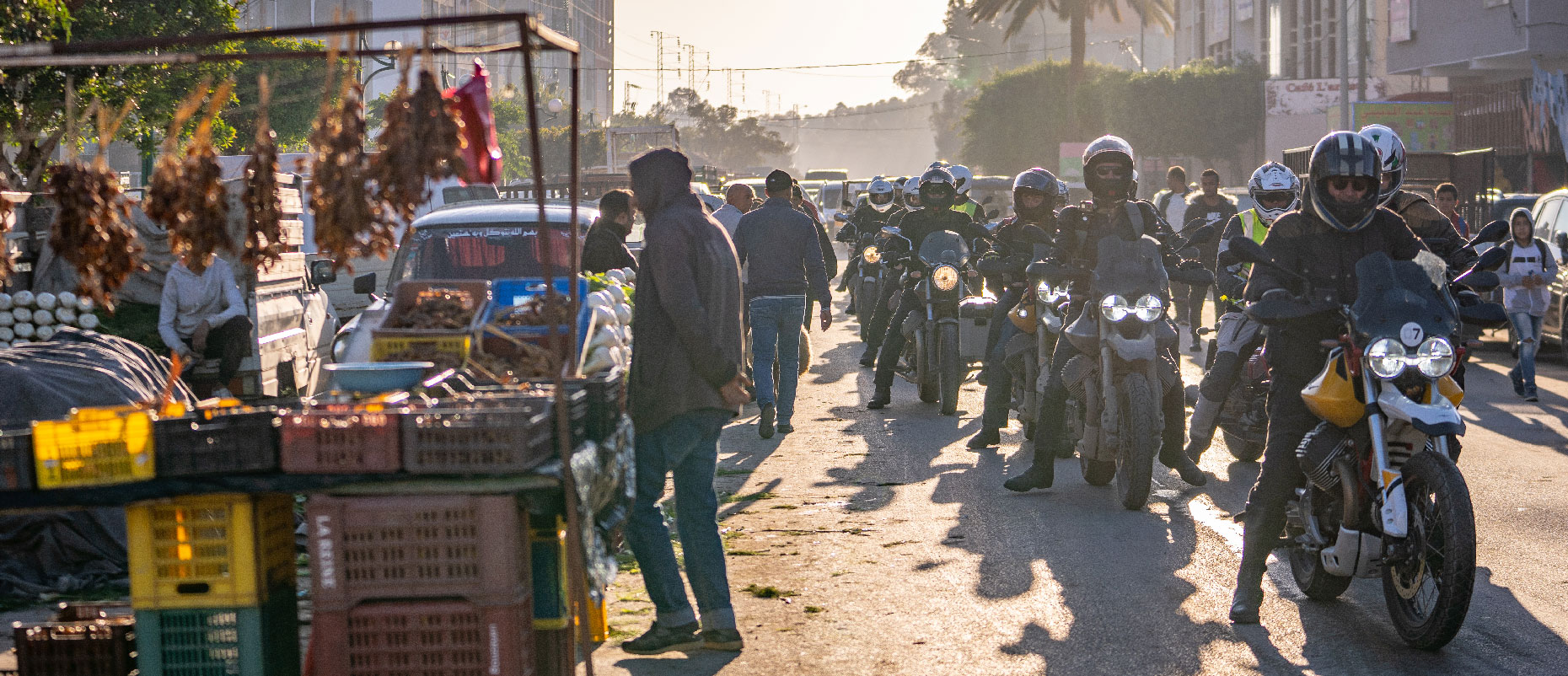 The last day in the saddle, the last bags to load into the van, the last stagger in search of our bike among the line of no-longer-spotless parked Moto Guzzi. This evening at 7 we should be sailing off the Tunisian coast.
The last day in the saddle, the last bags to load into the van, the last stagger in search of our bike among the line of no-longer-spotless parked Moto Guzzi. This evening at 7 we should be sailing off the Tunisian coast.
Each of us reacts in their own way: some are quieter, some begin to collect phone numbers and selfies, some ask to ride the last bike in the range, seeking to complete their very own special “Eagle” score card.
Are we bikers really so terribly sentimental? So it would seem. Luckily, ahead of us there is still almost a full day’s travel, ideal for putting our wheels back on the ground.
The key feature of today’s programme is a visit to the medina (old town) of Kairouan, the fourth holy city of Islam in importance. “Seven pilgrimages here are worth one to Mecca,” a Tunisian boy we meet at the venerable Great Mosque tells us. Entry to the prayer hall is forbidden to non-Muslims, but the architectural building is magnificent: it covers a surface area of 9,000 m², with a perimeter measuring around 415 m. A white sundial sits in the centre of the courtyard, near to a pool collecting rainwater, and all around the fortified walls and porticoes with their granite and porphyry columns, stolen from ancient monuments in Carthage.
Just three of us left, and our new friend invites us to climb up to a terrace next to the Great Mosque, to enjoy the view from above. We cross 3 storeys of carpet shops and the view is truly breathtaking. Kairouan is considered to be the carpet capital of Tunisia, and our guide asks if we wish to buy one. We say no, and he doesn’t push it, so we thank him for the small gift he has given us: “Chokran!” This means thank you in Tunisian: one of the few words we have managed to learn.
We reach Hammamet in time to enjoy some fried fish near the beach. The medina and sea promenade are well looked after, but the whole city smells of the Eastern European tourism of large resorts, which has little to do with the spirit of our Moto Guzzi Experience.
We cover the last 70 km to the port of Tunis quickly along the motorway, but the embarkation procedures seem never-ending, with a clumsy attempted swindle by a customs officer to boot. Our expert guides easily get us out of the sticky situation and soon we are sailing for Italy.
We think back over the almost 2,000 km we covered in Tunisia, the fears we had before we left, the crisis in the tourism industry following the Arab Spring and the attacks of 2015 and the slow recovery which we would like to see driven by people who, like us, decide to follow their passion for discovery, adventure and, of course, motorbikes.
We think of our travel companions, and how to translate the profound sense of fulfilment and belonging to a community that we are left with into words and gestures.
We think of our Moto Guzzi bikes, which behaved exceptionally well: from the small V7 to the grand MGX-21 (the favourite of our most “expert” rider: 76 years old, with the energy of a youngster), without forgetting the V85 TT. We should set aside a whole chapter for the Tuttoterreno to tell the story of its second journey, towards the Sahara, where many years ago its direct ancestor with a very similar livery raced towards Dakar.
They rest, covered in dust, in the ship’s hold, but for us they have been far more than just a means of transportation: they have been the “laissez-passer” of this thrilling travel experience, the free pass for a unique and exclusive discovery of this extraordinary country.
Chokran Tunisia! Chokran Moto Guzzi Experience!







Do you want to read the full article?
LOGIN
Related content
MG Experience 2023: choose your next adventures!
15 Feb 2023Ride and Shoot: Road to Wheels and Waves 2022
29 Sep 2022